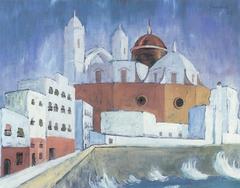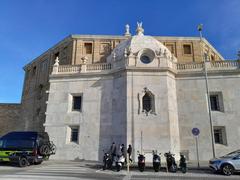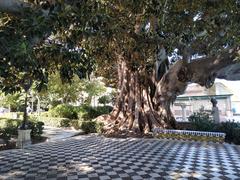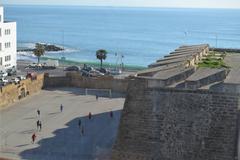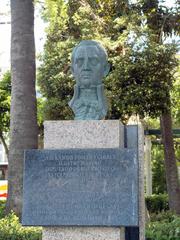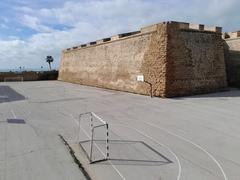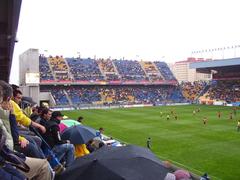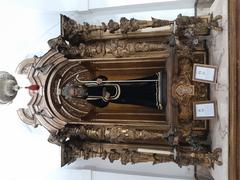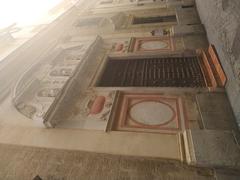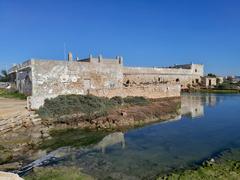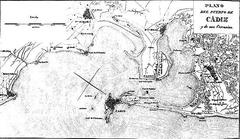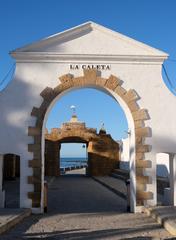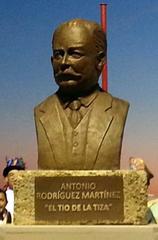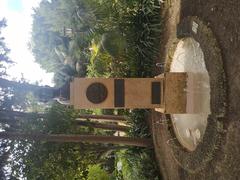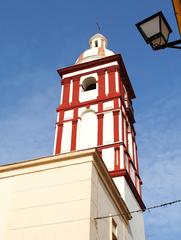
Cádiz Cathedral: Visiting Hours, Tickets, and an In-Depth Guide to Cádiz Historical Sites
Date: 14/06/2025
Introduction
Cádiz Cathedral, officially known as “Santa Cruz sobre el Mar,” rises majestically along the southern coast of Spain, serving as a beacon of faith and a testament to Cádiz’s maritime legacy. With its striking golden dome, eclectic architectural styles, and central location, the cathedral stands as one of Andalusia’s most significant historical and cultural landmarks. This comprehensive guide covers everything you need for your visit—from Cádiz Cathedral visiting hours and ticket prices to detailed historical context, accessibility, and practical travel tips—ensuring an enriching experience for every visitor (Visiting Cádiz; Oway Tours; España Guide).
Table of Contents
- Historical Background
- Key Features and Artistic Heritage
- Visitor Information
- Historical and Cultural Context
- Frequently Asked Questions (FAQs)
- Nearby Attractions and Enhancing Your Visit
- Local Etiquette and Practical Tips
- Summary and Call to Action
- References
Historical Background
Origins and Construction Motivation
The construction of Cádiz Cathedral began in 1722, a direct response to the city’s burgeoning wealth and prominence as Spain’s main port for transatlantic trade in the 18th century. As the city flourished, local elites sought to replace the older Iglesia Santa Cruz with a grand cathedral that would embody Cádiz’s “golden age” and reflect its new status on the world stage (Visiting Cádiz).
Architectural Vision and Influences
The initial vision, crafted by architect Vicente Acero, blended Spanish traditions with contemporary European trends. The cathedral’s Latin cross floor plan, fluted Corinthian columns, and three spacious naves were inspired by the grandeur of cathedrals in Granada and Guadix. The design journey transitioned from Baroque exuberance to Neoclassical restraint, a reflection of shifting tastes over the century-long construction period (Visiting Cádiz; Oway Tours).
Construction Timeline and Stylistic Evolution
The cathedral’s construction stretched until 1838, resulting in a patchwork of styles. The lower sections and initial chapels are Baroque, while the upper towers and main façade boast Neoclassical elements. The golden dome—completed in the 19th century with yellow ceramic tiles—became Cádiz’s iconic symbol, visible from both land and sea (Andalucia Lovers).
Key Features and Artistic Heritage
Chapels, Crypt, and Artistic Elements
Inside, Cádiz Cathedral features 16 chapels, each adorned with religious art, sculptures, and altarpieces. The crypt, completed in 1732, is the cathedral’s oldest part and the final resting place of notable figures including composer Manuel de Falla and writer José María Pemán (España Guide). The high altar, made of Italian marble, is a focal point, while the choir stalls, historic organs, and stained glass bathe the interior in light.
Towers and Dome
The cathedral’s twin towers, particularly the Torre de Poniente, are accessible to visitors. A climb to the top rewards you with panoramic vistas of Cádiz, the harbor, and the Atlantic Ocean. The iconic golden dome, covered in yellow azulejos, was designed as a navigational landmark for ships and remains a defining feature of the Cádiz skyline (España Guide; Oway Tours).
Visitor Information
Visiting Hours
- Monday to Saturday: 10:00 AM – 7:00 PM
- Sundays: 1:30 PM – 7:00 PM
Hours may vary on religious holidays; check the official website before your visit (España Guide; Visit Andalucia).
Tickets and Admission
- General Admission: €8
- Seniors: €7
- Students (13–25): €6
- Children under 12: Free
Tickets include access to the cathedral, crypt, and Torre de Poniente. Purchase tickets at the entrance or online to avoid queues, especially during peak seasons (España Guide; Visit Andalucia).
Accessibility
- The main nave and chapels are wheelchair accessible via ramps and elevators.
- The tower climb is not suitable for those with mobility issues or very young children.
- Service animals are welcome; accessible restrooms are available (Visit Andalucia).
Guided Tours and Tips
- Audio guides are offered in multiple languages, enhancing your understanding of the cathedral’s history and art.
- Guided tours (for groups or individuals) can be arranged in advance, often including access to special areas.
- Download the Audiala app for interactive maps and self-guided tour options.
Practical Tips
- Best Time to Visit: Early mornings or late afternoons for fewer crowds and optimal light.
- Dress Code: Modest attire required; shoulders and knees should be covered.
- Photography: Allowed in most areas without flash; restrictions may apply during services.
- Language: English signage is limited—consider an audio guide or translation app (Visiting Cádiz).
Historical and Cultural Context
Cádiz’s Golden Age
The cathedral’s construction paralleled Cádiz’s rise as a transatlantic hub, symbolizing the city’s prosperity and cosmopolitan identity during the 18th century (andalucia.com). Its nickname, “Cathedral of the Americas,” underscores its spiritual and economic ties to Spain’s colonial era.
Civic and Religious Role
Cádiz Cathedral remains the seat of the Diocese of Cádiz and Ceuta, hosting major religious celebrations such as Semana Santa and Corpus Christi. Its bells mark the rhythms of city life and its silhouette is a symbol of local resilience (nomads-travel-guide.com).
Artistic Heritage
The adjacent Cathedral Museum displays religious art, silverwork, and the mahogany table where the 1812 Spanish Constitution was signed, providing deeper insight into Cádiz’s history (Barceló Guide).
Frequently Asked Questions (FAQs)
Q: What are the Cádiz Cathedral visiting hours?
A: Monday to Saturday from 10:00 AM to 7:00 PM, and Sundays from 1:30 PM to 7:00 PM. Hours may change during holidays.
Q: How much are Cádiz Cathedral tickets?
A: General admission is €8; discounts available for seniors and students; children under 12 enter free.
Q: Is the cathedral accessible to people with disabilities?
A: Yes, the main areas are accessible, but the tower climb is not suitable for those with mobility issues.
Q: Are guided tours available?
A: Yes, in multiple languages. Audio guides and interactive apps are also available.
Q: Are there nearby attractions?
A: Yes—Roman Theatre, Torre Tavira, Mercado Central, Genovés Gardens, and the El Pópulo neighborhood are all within walking distance.
Nearby Attractions and Enhancing Your Visit
After visiting the cathedral, explore Cádiz’s other historical gems. The Roman Theatre, Torre Tavira with its camera obscura, and the lively Mercado Central offer insights into the city’s past and present (Visiting Cádiz). Enjoy local cuisine in nearby cafés, stroll through El Pópulo’s medieval streets, or relax in the Genovés Gardens—all easily accessible from Plaza de la Catedral.
Local Etiquette and Practical Tips
- Greetings: A friendly “hola” is always appreciated.
- Meal Times: Lunch is around 2:00 PM; dinner after 9:00 PM.
- Safety: Cádiz is generally safe, but mind your belongings in crowded areas (The Viva La Vita).
- Dress respectfully in religious spaces, especially during Mass or festivals.
Summary
Cádiz Cathedral encapsulates the city’s rich maritime legacy, architectural innovation, and enduring civic pride. Its golden dome, panoramic towers, and artistic treasures make it a cornerstone of Cádiz’s identity. Plan your visit around the official Cádiz Cathedral visiting hours, secure your tickets in advance, and enrich your experience with guided tours or the Audiala app. With its accessibility, central location, and proximity to other Cádiz historical sites, the cathedral is a must-see for any traveler seeking to immerse themselves in Andalusia’s cultural wealth (Visiting Cádiz; Oway Tours; España Guide).
Call to Action
Download the Audiala app for interactive tours, up-to-date information, and insider tips. Follow us on social media for the latest updates on Cádiz Cathedral visiting hours, ticketing, and local events. Prepare for a memorable journey into the heart of Cádiz’s history—plan your visit today!
